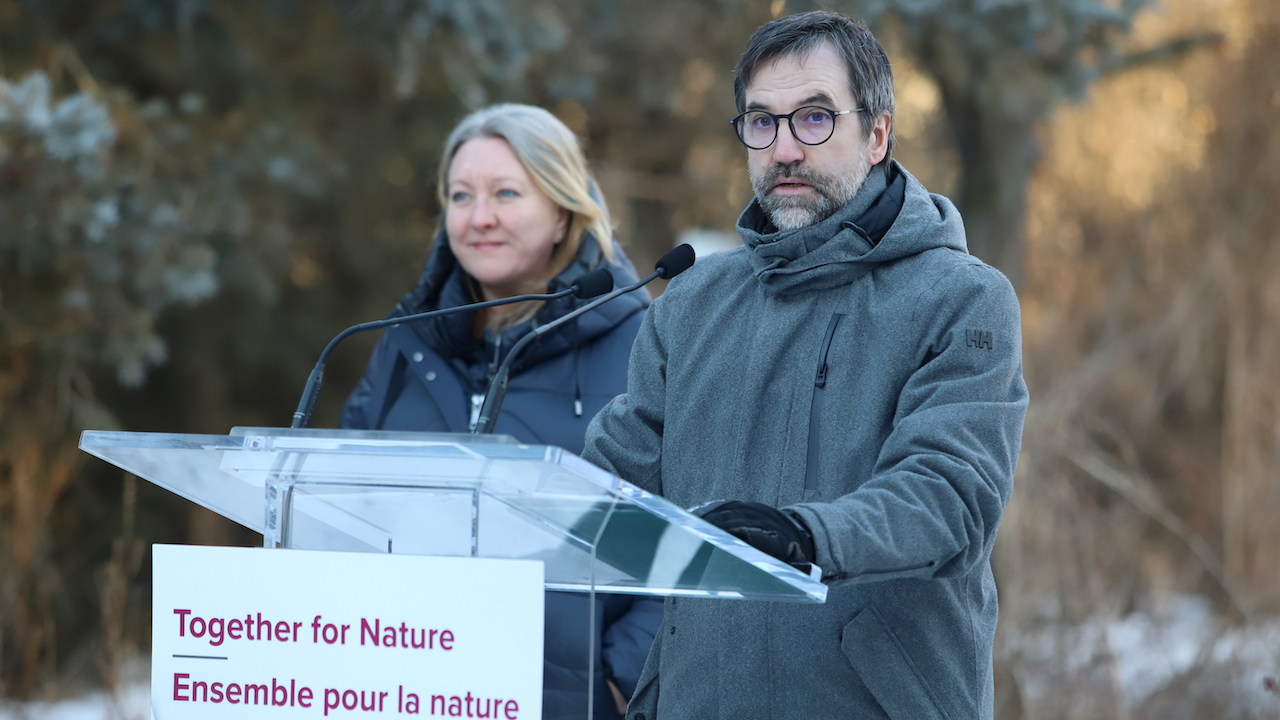ANALYSIS: A new report from Environmental Defence argues that the lack of consistent, reliable operations funding is also sabotaging Canada’s climate ambitions
Written by John Michael McGrath
Feb 27, 2024

Minister of Environment and Climate Change Steven Guilbeault makes a funding announcement in Ottawa on February 14. (Patrick Doyle/CP)
One of the oldest complaints around Toronto city hall is that, even when the higher orders of government (the province and feds) can be bargained into eventually, often begrudgingly, showing up to help fund major transit projects, the costs of operating those projects over the long term is left to the municipality. This leaves the most basic question of transit operations — will a bus or train actually show up when we need it? — at the mercy of municipal budgets and, by extension, the often toxic politics of property-tax increases.
A new report from Environmental Defence argues that the lack of consistent, reliable operations funding from the governments that can best afford it is also sabotaging Canada’s climate ambitions.

“Due to infrequent and unreliable public transit, the majority of Canadians are forced to drive cars,” says Nate Wallace, clean-transportation program manager at the environmental-advocacy group. “Canada can actually catch up with our peer countries and double transit ridership by 2035.”
Transportation is the second-biggest source of greenhouse-gas pollution nationwide. And, in Ontario, (courtesy of a largely decarbonized electricity system) it’s actually the biggest, period. According to the federally collected national-emissions inventory, Ontario’s emissions from light passenger vehicles alone — cars, trucks, and motorcycles — are almost as high as the emissions from all of the province’s heavy industry (26.7 megatonnes of carbon dioxide equivalent for drivers versus 27.6 for industry.)
“The question isn’t should the federal government be involved in transit funding, because it already is. The question that’s more important is: Is the current policy approach succeeding and driving the changes we need to combat climate change? The answer, based on the data, is no,” Wallace says.
The good news is that the emissions from these trips can be avoided if there’s a concerted effort to replace car and SUV trips with transit.
Environmental Defence has proposed a plan that features several major pillars, including consistent federal and provincial funding to improve service levels for existing transit (simply reactivating the buses currently idle from post-COVID service declines would be a good start, but adding service during off-peak hours is also important) and a major push to expand rapid bus lanes in Canadian cities; major planning reforms to ensure that people can move to the places where transit would enable them to live car-free or car-light lives; policies to make zero-emissions public transit (particularly electric buses) a core part of transit planning; and an overall target geared toward reducing the vehicle-kilometres travelled in Canada by 35 per cent by 2035, shifting individual commutes to transit.
How much would it cost higher levels of government to fund this kind of major shift? The report estimates the federal government would have to provide $1.6 billion in 2025; the number would climb to $4 billion by 2035. In Ontario, the report projects the provincial cost would be $1 billion in 2025 and $2.5 billion by 2035.
Environmental Defence estimates that the cumulative emissions reductions could add up to 65 million megatonnes nationwide by 2035. That would amount to more the double all of Ontario’s transportation emissions — or a bit less than half of Alberta’s oil and gas emissions. The vast majority of those emissions would come from people changing their behaviour as transit became more accessible and reliable in their neighbourhoods and from neighbourhoods changing through more transit-oriented planning.
“When someone ditches the car and relies more on transit, they don’t just make the same trips by bus — they make different trips,” says Wallace. “They’re more likely to walk to the local grocery store instead of driving to Costco.”
Notably, this magnitude of GHG reduction would also be bigger than what the federal government is projecting from its policies on electric-vehicle adoption: even when the industry starts selling only zero-emissions new cars, it will still take years, if not decades, for emissions to fall to zero, as cars have long afterlives in the used-car market.
Convincing government to pursue the plan would be an uphill battle — the feds are currently facing numerous expensive demands, and Canada’s finance ministry is trying to work down the massive deficits incurred in recent years. It might be even tougher to win over Conservatives, who’ve historically been skeptical of federal intervention in areas of local and provincial jurisdiction: for months, polling has showed that Conservative leader Pierre Poilievre is heavily favoured to win the next election, which means any transit plan that needs to survive until 2035 would also need to survive a potential Conservative election win. Wallace says a big push on transit would offer substantive climate policy not entangled with the federal carbon tax Poilievre has pledged to abolish.
“For Conservatives, I would say, they need to have a credible climate plan. If they don’t believe in carbon pricing, they need to replace that with something that fills in that gap,” Wallace says. “You’ve got to come up with at least something.”

John Michael McGrath is a staff writer at TVO.org covering provincial politics and policy.@jm_mcgrath

No comments:
Post a Comment